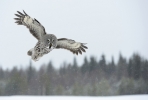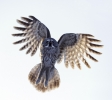Blog
OWL GOES FISHING (09.01.2014)
Graceful predators with gorgeous plumage sharply captured at the crucial moment of the hunt — it is a dream shot for any wildlife photo enthusiast. It turns out, that this is not too hard to achieve. You only have to know the right places and the best time to capture great images.
Jari PELTOMÄKI
Born in 1965. Professional wildlife photographer. Lives in Liminka, Finland. Engaged in photography for over 35 years. Multiple award winner of The Glanzlichter, Wildlife Photographer of the Year and many other international contests. Since 2007 he has been the chairman of The Professional Nature Photographers of Finland, and also Director of Finnature, Finland's leading wildlife tour agency. Taking photos of birds is his passion, owls are his main interest, therefore in his country he is known as «owlman».
Jari is often asked, what is the best time for observing and photographing owls. A good time for a photoshoot with owls is the second half of winter and early spring, from January to March. However, depending on the year, owls can be successfully observed in the Spring, Summer and even Fall. In the wild, there is no 100% guarantee, but a situation, when there is a lot of owls and they are readily available, may last for many weeks and, sometimes, even months!
Some owls are residents, they do not leave their territory throughout the year. Others cover considerable distances during the fall: they look for places to hunt for voles. When such a place is found, owls stay and winter there, and if there is still enough food in the spring, they can reproduce in the same area.
What is going on with the mouse population — that is the big question to consider when we discuss the possibility of observing and photographing owls. When there is plenty of mice, the owls breed well but hunt only during the twilight hours. When the mouse population decreases, the owls can be seen much more often and it becomes much easier to photograph them, especially during the winter! Populations of mice change periodically, as well as geographically. For instance, one year there are a lot of mice in Southern Finland, next year — in Central Finland, a year later — in Northern Finland. Therefore we can estimate in advance, how the vole population will change with time.
Owls of Finland
In good years, there are ten species of owls nesting in Finland. Eight of them are wide-spread in the regions of Oulu and Kuusamo: Eagle-Owl, Great Grey Owl, Ural owl, hawk-owl, marsh and long-eared owls, boreal owl and pygmy-owl. All of them are very interesting, but Great Grey Owl and blistering hawk-owls particularly attract the attention of photographers.
In some countries, including Finland, Great Gray Owl is called "Lapland owl" – a beautiful name, albeit not quite appropriate. This owl species is quite rare in Lapland. Rather, its main breeding area is located in Central Finland, from North Karelia to Northern Ostrobothnia (the Oulu region).
During some winters, usually from January to March when there is not enough food, Great Grey Owls are hunting in open fields in daylight. When a vole population is large, Great Grey Owls are hunting only at nights (in which case they are not easy to find). The best way to find hunting grounds of a Great Grey Owl is exploring footprints in the snow. When the owl attacks the lurking vole, its plumage leaves signature "angel" footprints on the snow surface. In search of mice, owls rely on their exquisite hearing and can penetrate the snow cover half a meter thick. However, when the snow is covered with ice crust, vole hunting becomes more difficult for Great Grey Owls, they do not have enough food, and at this time the birds can be observed during the day.
Great Grey Owls can also be easily found and photographed during the nesting season (May – June). At this time of the year, the owls are most active at dusk, after sunset and before dawn.
Hawk-owls are inveterate wanderers – in some years, they are more common in Southern Finland, in other – in the northern part of the country. From November to March, hawk-owls stick to a small area, and later in the spring they often nest nearby (especially in Northern Finland). It is easier to photograph them in the winter on open ground.
How to Take Photos of Hunting Owls
So, if everything clicked into place – the mouse population is large enough, the birds are staying to winter – there is a good chance to take a picture of the predators while they are hunting. Winter (from late January to early March) is the best season for shooting owls: a thick layer of virgin snow lies everywhere and there is enough natural light to capture fast action.
During this period, hawk-owls and Great Grey Owls are just sitting on the tree-tops seemingly doing nothing. If you are lucky, you will see how the owl catches the mouse, although, of course, you will not have time to photograph it.
So what is to be done? Do not worry, like any creature, an owl can be fooled by a good bait. Hawk-owls and Great Grey Owls feed on small rodents. Fortunately, pet snakes prefer a similar diet. For that reason, refrigerators of pet shops are filled with frozen mice and rats. All you need to a start is to imagine you are the master of a very hungry boa and buy loads of mice.
But it is still not enough. A dead mouse will not jump up on the snow to attract the attention of an owl. To “animate” the bait you will need a fishing rod and a fishing line. The mice should be unfrozen and tied with a string to the line. The string (or its node) must be easily torn when the owl seizes its prey. Now you are ready to go. Yes, of course, it all looks ridiculous – an occasional passer-by, who may find you at the verge of forest with a dead mouse on the rod, will remember the eccentric "fisherman" for a long time. But we do not care about passers-by!
Speed is Everything
Find a good background for your photoshoot: a dense verge of forest (no houses, telegraph poles, etc.) and a virgin snow surface. Choose a location, put the bait down and powder it lightly with snow. The distance to the mouse depends on the focal length of your lens, it is usually 20-30 meters. After setting up your camera, start slowly moving the mouse in the snow. Do not pull the bait evenly, instead twitch it gently. And do not take your eyes off the owl.
When the owl flies from the tree in the direction of the mouse – act immediately! A few seconds later it is all over: empty fishing line remains in the snow, and the owl with its prey flies back. Whether you will have time to catch the moment depends on how fast your reaction, your camera and lens are.
The owl abruptly "dives" from the tree towards the snow surface to reach maximum speed, and at this fast speed, approaches the prey. It is indeed a blistering bird. Only a fast lens and camera will let you to lock the focus on the bird and follow it all the way to its target. Better set up your camera to 'Shutter Speed Priority' mode and set the shutter speed of about 1/3200 sec. ISO value should be set at the maximum, as far as quality permits. At the time of shooting the camera will automatically adjust the appropriate aperture value. And since you are photographing a bird against a white snow background, do not forget to use exposure compensation: +2/3 – 1 EV.
If your camera is not fast enough for shooting an owl in flight, turn off autofocus and manually adjust the focus on the bait. When an owl seizes a mouse, she closes her eyes. It is clearly visible on the picture and looks bad, so choose the focus point in front or behind the bait. The faster the camera shoots a series of frames, the more likely you will get a sharp picture. You can shoot hand-held or you can use a tripod – at your convenience. The main thing to remember during a photo shoot with owls (especially with a hawk-owl): speed is everything.
Over and Over Again
Do not get discouraged if you fail at first. Hawk-owls are almost always willing to "collaborate". They are active during the day and bite at the bait fast. After catching several mice on the line, they start chasing after the bait freely thrown on the snow. In addition, they lay away all the food that can not be eaten right away. Therefore, within the same "photo shoot" you can offer an owl several mice in a row and try to take shots over and over again. After such training, owls begin to come after the food daily on their own and sit on the same tree. So the only serious problem you may encounter during such a photo shoot is the depletion of frozen mice at the local pet shop.
Planning and conducting a successful owl photo-shoot all by yourself is always anything but simple. Inviting a good guide helps a lot. Professional guides know, where the owls reside, they have large mouse stocks in their freezers and they are even ready to twitch the bait while you are busy adjusting the focus. Then you only have to take your dream shot of a lifetime!
I AM Photographer Festival 2014
A new "Book of Owls" by Jari PELTOMÄKI will be published in spring 2014. The author plans to organize its presentation during the I AM Photographer Festival 2014 in Tallinn, Estonia, where he will give a lecture entitled "Photographing the Owls of Finland" on April 4. Jari will tell you when and where to shoot owls, why Great Grey Owl is considered “the sexiest bird species in Finland”, he will also reveal the secrets behind some of his photos.
Text and photos: Jari PELTOMÄKI
Foto-Video, www.foto-video.ru










